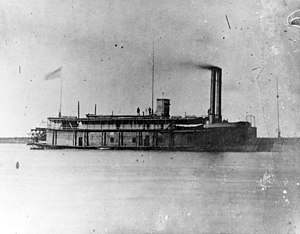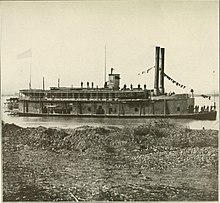USS Signal (1862)
 USS Signal tinclad, circa 1863–64
| |
| History | |
|---|---|
| Launched | 1862 |
| In service | circa 22 October 1862 |
| Fate | Burned 5 May 1864 |
| General characteristics | |
| Displacement | 190 tons |
| Length | 157 ft (48 m) |
| Beam | 30 ft (9.1 m) |
| Draft | 1 ft 10 in (0.56 m) |
| Depth of hold | 4 ft 4 in (1.32 m) |
| Propulsion |
|
| Armament |
|
USS Signal – a small 190-ton steamship – was acquired during the second year of the American Civil War by the Union Navy and outfitted as a gunboat. She also served other types of duty, such as that of dispatch vessel and convoy escort.
Service history

The first ship to be named Signal by the Navy—a wooden-hulled, stern-wheel steamer built in 1862 at
Signal's work for the day steaming up and down shallow, winding streams in hostile territory was a sample of the service she would perform throughout her career. She and Marmora again ascended the Yazoo on 11 December to obtain information needed for a projected joint Army-Navy expedition in that area to outflank Vicksburg. They discovered Confederates had placed

On 4 January 1863, Signal got underway in an expedition up the
Loss
On 4 May, Signal was ordered "to take on board a bearer of dispatches from Mayor General
In the ensuing battle, Signal was disabled and ran aground where she was reluctantly set afire and abandoned by her crew which was captured ashore. The two other ships were also lost. However, most of the crew of Covington, along with Covington's captain, managed to escape and make its way back to safety at Alexandria. Signal's captured crew was held at the Camp Ford prisoner of war camp near Tyler, Texas. The prisoner exchange lists show thirty-nine men from this vessel as being exchanged from this camp. Six of the crew members, Quarter Gunner Charles Asten, Gunner's Mate George Butts, Seaman John Hyland, Seaman Timothy O'Donoghue, Boatswain's Mate Michael McCormick, and Pilot Perry Wilkes, were awarded the Medal of Honor for their conduct during the ship's final engagement on the Red River.[1]
See also
- Anaconda Plan
- Mississippi Squadron
References
![]() This article incorporates text from the public domain Dictionary of American Naval Fighting Ships. The entry can be found here.
This article incorporates text from the public domain Dictionary of American Naval Fighting Ships. The entry can be found here.
- ^ ISBN 978-0-7864-3579-1.
External links
